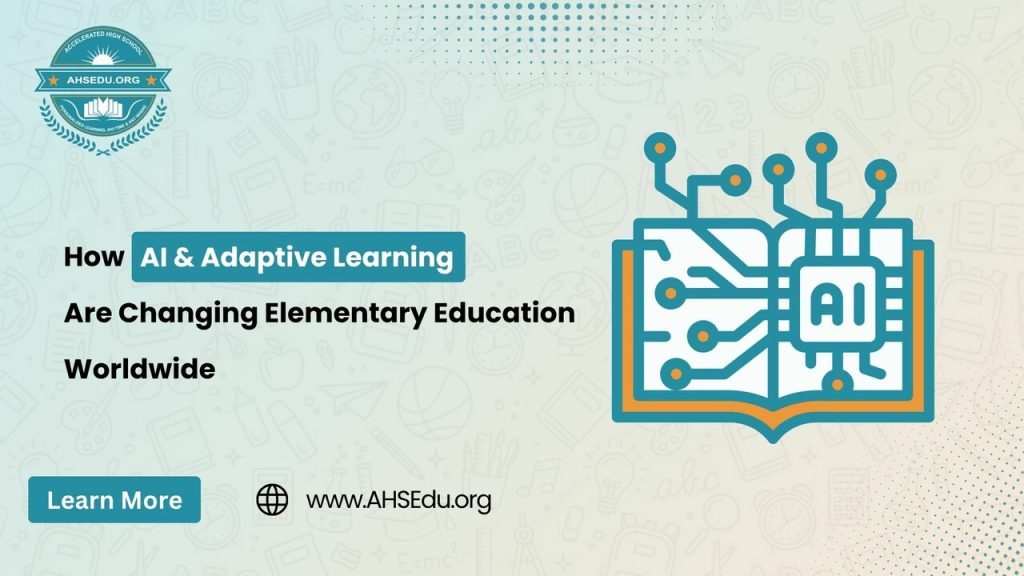
In recent years, artificial intelligence (AI) and machine learning (ML) have enabled new models of teaching and learning, especially through adaptive systems that adjust to each student’s needs. According to EdTech forecasts for 2025, AI-driven personalized learning systems are among the top innovations reshaping schools today (Digital Learning Institute).
For elementary grades, where children build foundational skills, these technologies offer a critical advantage: helping students who might otherwise fall behind to stay engaged, challenged, and supported.
This article explains what adaptive learning looks like in Grades 1–5, shares examples of global adoption, and offers guidance for choosing a solution—highlighting how AHS Education is already aligned with this transformation.
What “Adaptive Learning” Means for Grades 1–5
Adaptive learning is a method where technology personalizes instruction based on how each student learns. Instead of a single fixed lesson, adaptive systems:
• Assess a child’s current knowledge
• Adjust the content difficulty or pace
• Provide personalized feedback and support in real time
• Track progress to guide teachers and parents
“Adaptive learning refers to an educational approach that uses data-driven algorithms to adjust the content, the delivery, and the pace of instruction based on learners’ performance and engagement.”
— MDPI Education Journal
For younger students, this could mean offering extra practice on basic addition before moving to multiplication, or reviewing phonics skills before introducing new vocabulary.
Studies have shown this approach works. One review found that AI-enabled adaptive learning improved test results by up to 62% (ScienceDirect). Other reports show students in personalized environments scoring 30% higher on standardized tests than peers in traditional classrooms (MATSH).
Real-World Examples of AI in Elementary Classrooms

China: Mandating AI in Classrooms from Primary Level
In 2025, Beijing’s education department introduced a policy requiring all students—including elementary learners—to receive AI instruction. This reflects the country’s larger strategy to embed AI tools into the classroom experience from an early age (Business Insider).
Australia: Adaptive Tools in Primary Math
Platforms like Mathspace, used widely in Australian schools, rely on AI to adjust problems and hints based on each student’s ability. Students as young as 7 are using it to master math concepts through interactive, tailored learning experiences (Wikipedia).
Global EdTech Market Growth
Globally, the AI-in-education market is skyrocketing. It’s expected to grow from $540 million in 2025 to over $13.6 billion by 2035, with K–12 schools accounting for over 50% of current AI deployments (Future Market Insights, SQ Magazine).
Choosing the Right Adaptive Learning Solution
Here are key features parents and schools should look for and how AHS Education delivers on each one:
1. A Full, Standards-Aligned Curriculum
AHS provides a complete U.S. Grades 1–5 curriculum, covering all core subjects through interactive video lessons, auto-graded quizzes, and printable worksheets. Everything is aligned with state standards.
2. Adaptive, Personalized Learning Paths
Students learn at their own pace. With real-time tracking and teacher/parent dashboards, lessons adjust based on performance, just like leading adaptive platforms.
3. Offline & Mobile Access
AHS works even with limited or no internet. Students can learn on tablets, phones, or laptops, anywhere and anytime online. Or using the AHS offline program.
4. Easy Progress Monitoring
Teachers and parents can track learning through simple dashboards that highlight strengths and areas needing attention.
One study found that adaptive tools reduced time to mastery by 17% and gave educators early insights into learning gaps.
5. Zero Cost
Unlike many tools that cost hundreds per student per year, AHS Education is completely free for parents, schools, and nonprofits, making it accessible to all.
Why It Matters for Grades 1–5
The elementary years are a critical window. During these years, children develop:
• Reading fluency
• Basic math concepts
• Confidence in learning
• Love for curiosity and exploration
When students fall behind in early grades, the gap tends to widen each year. Adaptive tools can close this gap before it becomes a chasm.
They also make learning more fun and engaging. With personalized support and immediate feedback, students build confidence and momentum.
Free Access to Future-Ready Learning
Whether you’re a parent, school leader, or nonprofit educator, AHS offers a no-cost way to bring AI-enhanced, adaptive learning to your students.
For Parents
Track your child’s progress, access full curriculum, and let them learn independently and confidently.
Sign up free: AHSEdu.org/demo-for-parents
For Schools
Empower your classrooms with tools that adjust to each student and simplify lesson delivery.
Get your free school dashboard: AHSEdu.org/demo-for-institute
For Nonprofits
Equip learning centers and community programs with a full academic toolkit, free of charge.
Apply now: AHSEdu.org/demo-for-nonprofit
Conclusion
Artificial intelligence and adaptive learning systems are redefining education across the globe—especially in early grades. Whether it’s students in Beijing, Sydney, or underserved areas in the U.S., the trend is clear: personalized, tech-enhanced learning is here to stay.
As the demand for flexible, inclusive, and intelligent learning tools grows, AHS Education stands at the forefront, offering a full, engaging solution that’s not just effective but also free.
Don’t wait to give your learners the advantage of personalized learning.
Start your journey with AHS today.

AHSEDU.org offers personalized learning for every student. With a curriculum standardized with USA State Standards, Free interactive videos, Fun and interactive learning content, Constructive assessments, and take-home worksheets we address the unique educational needs of each learner to ensure success.